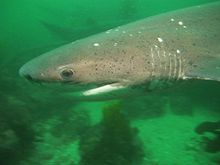Tiger catshark
| Tiger catshark | |
|---|---|

| |
| Scientific classification | |
| Domain: | Eukaryota |
| Kingdom: | Animalia |
| Phylum: | Chordata |
| Class: | Chondrichthyes |
| Subclass: | Elasmobranchii |
| Subdivision: | Selachimorpha |
| Order: | Carcharhiniformes |
| Family: | Scyliorhinidae |
| Genus: | Halaelurus |
| Species: | H. natalensis
|
| Binomial name | |
| Halaelurus natalensis (Regan, 1904)
| |

| |
| Range of the tiger catshark[2] | |
| Synonyms | |
|
Scyllium natalense Regan, 1904 | |
The tiger catshark (Halaelurus natalensis) is a species of catshark, belonging to the family Scyliorhinidae. It is found over sandy areas and near reef peripheries off South Africa and perhaps Mozambique, from close to shore to usually no deeper than 100 m (330 ft). Reaching a length of 50 cm (20 in), this small, slim shark has a broad, flattened head with an upturned snout tip. It can additionally be identified by its dorsal colour pattern of ten dark brown saddles on a yellowish brown background.
Taxonomy
British
Description
The body of the tiger catshark is slim and firm, and it grows up to 50 cm (20 in) long. The head is broad and flattened, with a distinct and upturned snout tip. The horizontally oval eyes are situated high on the head and protected by rudimentary nictitating membranes. Beneath each eye is a broad ridge, and behind is a spiracle. The medium-sized nostrils are divided by lobe-like flaps of skin on their anterior rims. The nasal flaps do not reach the large mouth, which forms a wide arch and bears short furrows around the corners. When the mouth is closed, the centre of the lower jaw falls well short of the upper, leaving the upper teeth exposed.[5] The teeth are small and 3-cusped (rarely 5-cusped), with the central cusp the longest.[6] The five pairs of gill slits are placed higher than the level of the mouth and face somewhat upwards.[5]
The
Distribution and habitat
The tiger catshark is
Biology and ecology

The tiger catshark is a sluggish
Reproduction in the tiger catshark is
Human interactions
Harmless to humans,
References
- ^ . Retrieved 19 November 2021.
- ^ ISBN 978-0-691-12072-0.
- .
- ^ ISBN 978-1-86825-394-4.
- ^ ISBN 978-92-5-101384-7.
- ^ a b c Bass, A. J.; D'Aubery, J. D.; Kistnasamy, N. (1975). Sharks of the east coast of southern Africa. II. The families Scyliorhinidae and Pseudotriakidae Archived 2012-03-03 at the Wayback Machine. South African Association for Marine Biological Research, Oceanographic Research Institute Investigational Report No. 37.
- .
- .
- S2CID 84782633. Archived from the original(PDF) on 2012-04-02.
- ^ Froese, R.; Pauly, D., eds. (2011). Halaelurus natalensis. FishBase. September 2011 version.

